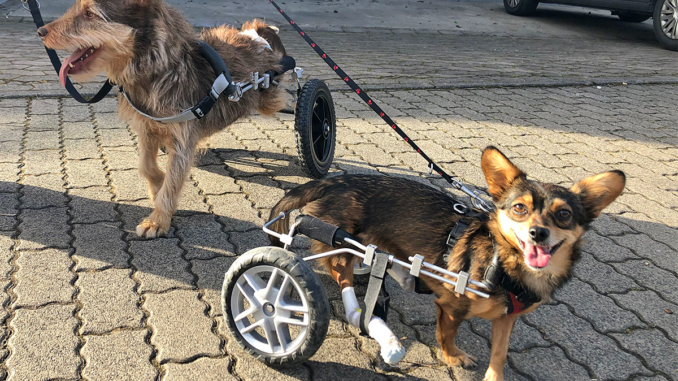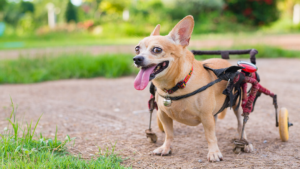
Introduction: A Special Cart for a Special Dog
Imagine being a dog who loves to go for walks, but one day you find yourself unable to move around like you used to. This is the story of a disabled dog whose loving owner refused to let its disability stop them from enjoying the great outdoors. With a little creativity and a lot of love, the owner found a way to ensure his dog could still take part in daily walks—thanks to a specially designed cart. It’s a touching reminder of how deep the bond between a man and his pet can go and how resourcefulness can help solve even the most challenging problems.
Let’s dive into this inspiring story of love, ingenuity, and the power of never giving up on your furry friend.
The Power of Walks: Why Dogs Love Them
Dogs have an innate love for walks. It’s not just about exercise; it’s about exploring the world around them, smelling new scents, and spending quality time with their human companions. For a disabled dog, the prospect of missing out on daily walks can be a heartbreaking reality. But for this particular dog, its devoted owner wasn’t going to let that happen.
Why Are Walks So Important for Dogs?
Walks offer dogs a chance to engage with their environment and provide mental stimulation. They are an essential part of a dog’s routine, not just for physical health but for emotional well-being too. So, when a dog becomes unable to walk, it can experience frustration, sadness, and anxiety. That’s why it’s so important to find solutions that allow these dogs to continue enjoying the activities they love.
The Heartbreaking Diagnosis: A Dog’s Struggle with Disability
At some point, this loving dog had suffered an injury or developed a condition that left it unable to walk or move around as it once had. The exact cause of its disability may have been physical trauma or perhaps a degenerative condition that affected its ability to move. Regardless of the reason, the once energetic dog found itself unable to participate in one of its favorite activities—going on walks.
What Happens When a Dog Can’t Walk?
When a dog becomes physically disabled, it can have a significant impact on both the dog and its owner. Dogs rely on their mobility to engage with their surroundings, and a lack of movement can lead to feelings of isolation, depression, and physical deterioration. This dog was no different. It missed its walks, the moments of joy that came with sniffing around and exploring new places.
A Man’s Devotion: How He Came Up with the Idea of a Special Cart
Not willing to accept that his dog would be forever limited in its movement, the dog’s owner decided to take action. He wanted to ensure that his disabled dog could continue enjoying the walks it loved so much. The solution? A special cart designed to carry the dog while allowing it to experience the outdoors like never before.
Why Did the Man Choose a Cart for His Dog?
A cart offers a practical solution for dogs who are unable to walk on their own due to injury or illness. It allows them to move around and enjoy walks again without putting additional strain on their bodies. The man knew that a cart could be the key to giving his dog the freedom it deserved, and he set out to find the perfect design.
Designing the Perfect Cart: A Tailored Solution
Creating a cart for a disabled dog is not a one-size-fits-all solution. It requires careful planning and customization to ensure the cart meets the dog’s specific needs. The man worked closely with a team of experts to create a cart that was comfortable, safe, and functional.
What Features Does a Special Cart Have?
A well-designed dog cart includes various features such as:
- Support for the dog’s body: The cart is designed to hold the dog’s body in a natural position, preventing discomfort and unnecessary pressure on joints.
- Lightweight frame: The cart’s frame is often made from durable yet lightweight materials to ensure the dog doesn’t feel weighed down.
- Adjustable components: The cart can be adjusted to fit the dog’s size and mobility needs, allowing for easy movement and flexibility.
- Wheels and stability: The cart is equipped with sturdy wheels to allow smooth movement over different terrains, from paved sidewalks to grassy parks.
The First Walk: A New Beginning
When the cart was finally ready, it was time for the dog to experience its first walk in its new mobility device. The dog, initially unsure, soon became excited as it realized it was going outside again. With each step, it grew more confident, and the bond between the dog and its owner strengthened.
How Did the Dog React to the Cart?
It’s natural for any dog to feel a little hesitant about something new, especially something that changes the way they move. However, this dog quickly adapted to the cart, and its joy was evident. The man’s patient and loving approach helped his dog understand that this new cart was not a barrier but a means to freedom.

The Joy of Walks: Enjoying the Outdoors Again
With the cart, the dog was able to experience all the joys of outdoor exploration once again. It could feel the breeze in its fur, sniff the scents of nearby flowers, and explore familiar places. What’s more, it could now go on longer walks, experiencing nature and engaging with the world in a way that had previously seemed impossible.
Why Does the Dog Enjoy Walks So Much?
For this dog, walks were about more than just physical exercise—they were about feeling alive, connected to the world, and bonded with its owner. The cart restored this sense of normalcy, allowing the dog to feel like itself once more.
The Emotional Impact: Strengthening the Bond Between Dog and Owner
This dog’s journey to recovery wasn’t just physical—it was emotional as well. The owner’s devotion to finding a solution for his dog’s disability strengthened their relationship, creating a deeper bond built on trust, care, and mutual understanding. The man’s willingness to invest time, effort, and resources into ensuring his dog’s happiness reflects the incredible power of the human-animal connection.
How Does the Cart Help Strengthen the Relationship?
By taking the time to find a solution, the owner demonstrated his love and commitment to his dog. The dog, in turn, likely feels more secure and loved, knowing that its human will always find a way to make its life better, no matter the circumstances. Their walks together are not only physical outings but also opportunities for emotional bonding.
Is This Solution for Every Disabled Dog?
While a cart is a great solution for many disabled dogs, it’s not suitable for every situation. It’s important for pet owners to consult with veterinarians and other professionals before investing in a cart. Some dogs may benefit from physical therapy, while others might require different types of mobility aids.
How Can I Tell if My Dog Needs a Cart?
If your dog has become unable to walk or move comfortably due to injury or illness, it might be time to explore options like a cart. Signs that a cart could be beneficial include difficulty walking, pain when trying to move, and a noticeable decrease in mobility. Always check with your vet before making any decisions.
The Benefits of Mobility Aids for Disabled Dogs
Mobility aids, like carts, provide dogs with the chance to regain some independence and maintain a good quality of life. These aids can help prevent muscle atrophy, increase circulation, and promote mental well-being. For a dog that loves its walks, a mobility aid can be a game-changer.
Conclusion: A Story of Love, Dedication, and Innovation
This touching story of a man ensuring his disabled dog continues to enjoy walks with a special cart is a powerful reminder of the lengths to which pet owners will go for their beloved companions. Through love, creativity, and determination, this owner turned his dog’s disability into an opportunity for joy and exploration. With the right tools and plenty of support, every dog deserves the chance to live a full, happy life—no matter their challenges.
FAQs:
1. Can all dogs use mobility carts?
Most dogs can use mobility carts, but it depends on their specific condition and size. Consult with a veterinarian to determine if a cart is right for your dog.
2. How do I know if my dog needs a mobility cart?
If your dog is having trouble walking or seems to be in pain, a mobility cart might be a helpful solution. Always check with a vet before getting one.
3. How long does it take for a dog to adjust to a cart?
Adjusting to a cart can take time. Some dogs adapt quickly, while others may need a little more time and patience. It’s important to let your dog take things at its own pace.
4. Are mobility carts expensive?
The cost of a mobility cart varies depending on the design and materials. Custom carts are generally more expensive, but they offer the best fit and comfort for your dog.
5. Can a mobility cart help with muscle atrophy?
Yes, mobility carts can help prevent muscle atrophy by allowing dogs to continue moving and using their muscles. They can also aid in maintaining good circulation.
